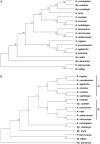Genome Size, Molecular Phylogeny, and Evolutionary History of the Tribe Aquilarieae (Thymelaeaceae), the Natural Source of Agarwood
- PMID: 29896211
- PMCID: PMC5987174
- DOI: 10.3389/fpls.2018.00712
Genome Size, Molecular Phylogeny, and Evolutionary History of the Tribe Aquilarieae (Thymelaeaceae), the Natural Source of Agarwood
Abstract
The tribe Aquilarieae of the family Thymelaeaceae consists of two genera, Aquilaria and Gyrinops, with a total of 30 species, distributed from northeast India, through southeast Asia and the south of China, to Papua New Guinea. They are an important botanical resource for fragrant agarwood, a prized product derived from injured or infected stems of these species. The aim of this study was to estimate the genome size of selected Aquilaria species and comprehend the evolutionary history of Aquilarieae speciation through molecular phylogeny. Five non-coding chloroplast DNA regions and a nuclear region were sequenced from 12 Aquilaria and three Gyrinops species. Phylogenetic trees constructed using combined chloroplast DNA sequences revealed relationships of the studied 15 members in Aquilarieae, while nuclear ribosomal DNA internal transcribed spacer (ITS) sequences showed a paraphyletic relationship between Aquilaria species from Indochina and Malesian. We exposed, for the first time, the estimated divergence time for Aquilarieae speciation, which was speculated to happen during the Miocene Epoch. The ancestral split and biogeographic pattern of studied species were discussed. Results showed no large variation in the 2C-values for the five Aquilaria species (1.35-2.23 pg). Further investigation into the genome size may provide additional information regarding ancestral traits and its evolution history.
Keywords: Aquilaria; Gyrinops; ITS gene; chloroplast genes; flow cytometry.
Figures



Similar articles
-
Cross-amplification of microsatellite markers across agarwood-producing species of the Aquilarieae tribe (Thymelaeaceae).3 Biotech. 2020 Mar;10(3):103. doi: 10.1007/s13205-020-2072-2. Epub 2020 Feb 7. 3 Biotech. 2020. PMID: 32099744 Free PMC article.
-
Phylogenetic Relatedness of Several Agarwood-Producing Taxa (Thymelaeaceae) from Indonesia.Trop Life Sci Res. 2018 Jul;29(2):13-28. doi: 10.21315/tlsr2018.29.2.2. Epub 2018 Jul 6. Trop Life Sci Res. 2018. PMID: 30112138 Free PMC article.
-
Comparison of eight complete chloroplast genomes of the endangered Aquilaria tree species (Thymelaeaceae) and their phylogenetic relationships.Sci Rep. 2020 Aug 3;10(1):13034. doi: 10.1038/s41598-020-70030-0. Sci Rep. 2020. PMID: 32747724 Free PMC article.
-
Chemical Constituents and Pharmacological Activity of Agarwood and Aquilaria Plants.Molecules. 2018 Feb 7;23(2):342. doi: 10.3390/molecules23020342. Molecules. 2018. PMID: 29414842 Free PMC article. Review.
-
Aquilaria Species (Thymelaeaceae) Distribution, Volatile and Non-Volatile Phytochemicals, Pharmacological Uses, Agarwood Grading System, and Induction Methods.Molecules. 2021 Dec 20;26(24):7708. doi: 10.3390/molecules26247708. Molecules. 2021. PMID: 34946790 Free PMC article. Review.
Cited by
-
Insights into Aquilaria phylogenetics through comparative plastomic resources.For Res (Fayettev). 2024 Sep 4;4:e030. doi: 10.48130/forres-0024-0028. eCollection 2024. For Res (Fayettev). 2024. PMID: 39524431 Free PMC article.
-
Cross-amplification of microsatellite markers across agarwood-producing species of the Aquilarieae tribe (Thymelaeaceae).3 Biotech. 2020 Mar;10(3):103. doi: 10.1007/s13205-020-2072-2. Epub 2020 Feb 7. 3 Biotech. 2020. PMID: 32099744 Free PMC article.
-
Highly divergent regions in the complete plastome sequences of Aquilaria are suitable for DNA barcoding applications including identifying species origin of agarwood products.3 Biotech. 2023 Mar;13(3):78. doi: 10.1007/s13205-023-03479-1. Epub 2023 Feb 7. 3 Biotech. 2023. PMID: 36761338 Free PMC article.
-
The complete chloroplast genome of Walla Patta, Gyrinops walla (Thymelaeaceae), an agarwood-producing tree species from Sri Lanka.Mitochondrial DNA B Resour. 2021 May 19;6(6):1699-1701. doi: 10.1080/23802359.2021.1926362. Mitochondrial DNA B Resour. 2021. PMID: 34104743 Free PMC article.
-
Comparison of DNA extraction methods on CITES-listed timber species and application in species authentication of commercial products using DNA barcoding.Sci Rep. 2023 Jan 4;13(1):151. doi: 10.1038/s41598-022-27195-7. Sci Rep. 2023. PMID: 36599919 Free PMC article.
References
-
- Adanson M. (1763). Familles des Plantes. Paris: Chez Vincent.
-
- Anderson J. A. R., Muller J. (1975). Palynological study of a holocene peat and a Miocene coal deposit from NW Borneo. Rev. Palaeobot. Palynol. 19 291–351. 10.1016/0034-6667(75)90049-4 - DOI
-
- Ashton P. S. (1992). “Plant conservation in the Malaysian region,” in Proceedings of the International Conference in Tropical Biodiversity –In Harmony with Nature, eds Yap S. K., Lee S. W. (Kuala Lumpur: Malayan Nature Society; ), 86–93.
-
- Ashton P. S. (1995). “Biogeography and ecology,” in Tree Flora of Sabah and Sarawak Vol. 1 eds Soepadmo E., Wong K. M. (Kuala Lumpur: Forest Research Institute Malaysia; ).
-
- Ashton P. S. (2014). On the Forests of Tropical Asia, Lest the Memory Fade. Kew: Royal Botanic Garden.
LinkOut - more resources
Full Text Sources
Other Literature Sources

